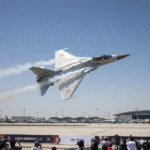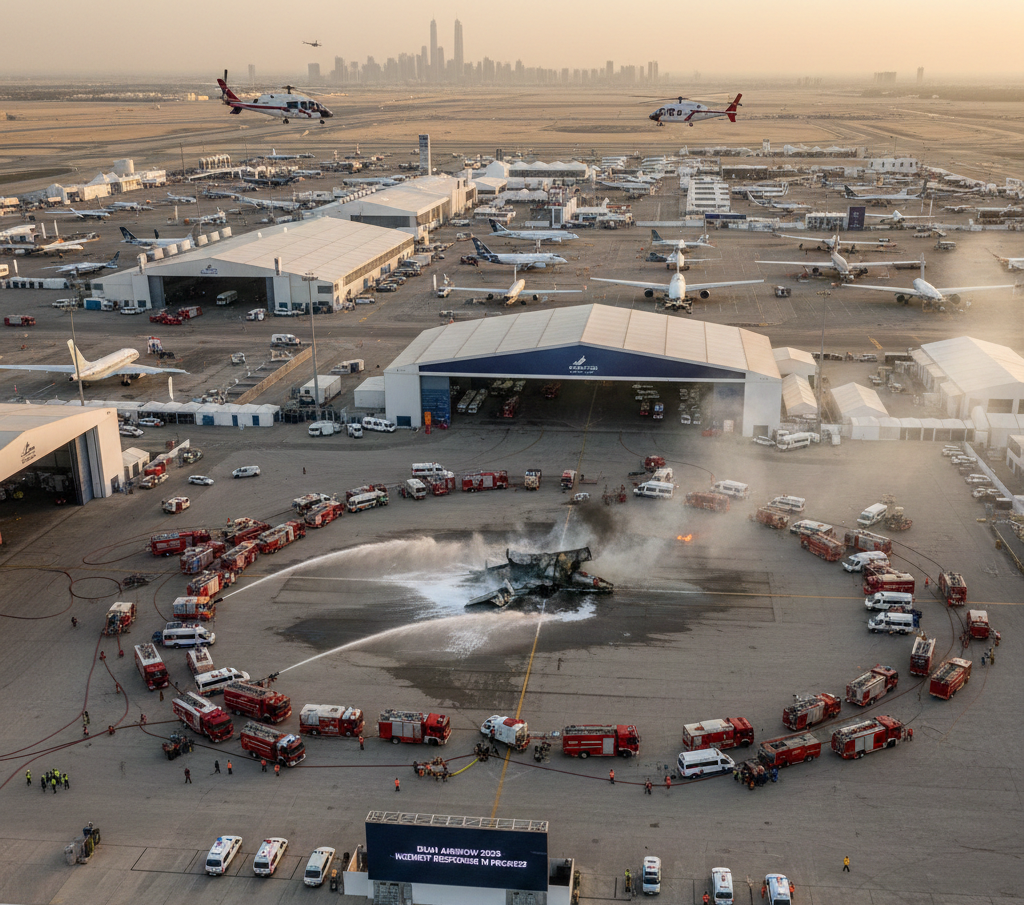The Tejas crash in Dubai on November 21, 2025, has shocked the aviation community worldwide. India’s indigenous HAL Tejas fighter jet went down during an aerial display at Dubai Airshow, tragically killing the pilot. This devastating incident has raised urgent questions about aircraft safety and the future of India’s defense program. Here’s everything you need to know.
The Tejas Crash Timeline: How It Happened
Around 2:10 PM local time, the Tejas jet was performing its scheduled aerobatic routine when disaster struck.
Key Moments:
- 2:10 PM: Tejas entered airspace at Al Maktoum International Airport
- 2:13 PM: During a steep climb, the aircraft suddenly lost altitude
- 2:14 PM: The jet crashed with heavy impact, sending black smoke into the sky
- Within minutes: Emergency teams rushed to the scene
- 90 minutes later: Airshow resumed with other displays
Thousands of spectators witnessed the horrifying moment. Video footage showed the aircraft losing power mid-ascent during what appeared to be a negative-G maneuver. The pilot sustained fatal injuries, and no ejection was observed.
What Caused the Tejas Dubai Crash?
The exact cause remains under investigation by the Indian Air Force Court of Inquiry.
Possible Factors Being Examined:
- Engine failure during the climb
- Flight control system malfunction
- Low-altitude maneuvering with insufficient recovery time
- Pilot unable to eject in time
- Pre-existing mechanical issues
The Oil Leak Controversy: A day before the crash, social media claimed a Tejas had an oil leak. India’s Press Information Bureau dismissed this as “false propaganda,” but questions remain about whether this was the same aircraft.
Tejas Crash History: How Many Crashes Total?
This is only the second Tejas crash in the program’s 23-year history and the first fatal accident.

Previous Crash – March 2024
- Location: Jaisalmer, Rajasthan, India
- Outcome: Pilot ejected safely and survived
- Cause: Engine seizure
- Aircraft: Tejas Mk1
Dubai Crash – November 2025
- Location: Dubai Airshow, UAE
- Outcome: Pilot killed
- Cause: Under investigation
- Aircraft: Tejas Mk1
READ MORE :- Tejas Crash in Dubai Show: Pilot Killed
Is Tejas Safe? Safety Record Comparison
With only two crashes over 23 years, the Tejas has a strong safety record compared to competitors.
Tejas vs JF-17 Thunder Safety
Tejas Safety Record:
- Total crashes: 2 in 23 years
- Fatalities: 1
- Service entry: 2015
- Operational fleet: Growing steadily
JF-17 Thunder (Pakistan):
- Total crashes: 4 since 2011
- Fatalities: At least 1 confirmed
- Service entry: 2007
- Known issues: Engine reliability problems
The Verdict: Tejas has a 4x better safety record than its regional competitor. The aircraft uses the reliable GE-404 engine with an excellent global track record, while the JF-17’s Chinese WS-13 engine has documented reliability issues.
Tejas Mk1A vs Mk1 Safety: Key Differences
The Dubai crash involved the Mk1 variant. India is now transitioning to the improved Mk1A version with enhanced safety features.
Mk1A Improvements:
- AESA radar for better situational awareness
- Advanced avionics and electronic warfare systems
- Enhanced flight control redundancy
- Improved pilot interface
- Better diagnostic systems
Impact on India’s Aviation Program
The crash carries significant implications for India’s defense ambitions.
Export Challenges: India has been marketing Tejas to countries like Malaysia, Egypt, Philippines, and Sri Lanka. This high-profile crash may affect buyer confidence.
Domestic Program:
- India ordered 83 Tejas Mk1A in 2021 and 97 more in September 2025
- Deliveries delayed due to US engine supply shortages
- New deliveries expected from 2027
- IAF needs Tejas to fill fighter squadron gaps
Investigation Timeline:
- Preliminary findings: 2-3 months
- Final report: 6-12 months
- Possible fleet-wide safety reviews
Featured Image Prompt
“Professional news photo of Indian HAL Tejas fighter jet performing at Dubai Airshow 2025, silver aircraft in mid-flight against blue sky, Al Maktoum Airport background, respectful editorial style, high resolution”
Additional Image Prompts
Image 2: Safety Comparison Chart
“Clean infographic comparing Tejas vs JF-17 safety statistics 2001-2025, bar charts showing crash data, aircraft silhouettes, professional blue and white design, easy-to-read data visualization”
Image 3: Dubai Airshow Scene
“Wide shot of Dubai Airshow 2025 venue with emergency response, professional documentary photography, respectful distance, organized emergency teams, no graphic content”
Conclusion
The Tejas crash in Dubai is a tragic setback that claimed a pilot’s life and raised safety concerns. However, context matters: with only two crashes in 23 years, the Tejas maintains a stronger safety record than comparable aircraft. The ongoing investigation will identify causes and drive improvements. India’s defense needs ensure the program continues, with lessons learned strengthening future operations. Our thoughts remain with the pilot’s family during this difficult time.
Frequently Asked Questions (FAQs)
1. What happened to Tejas in Dubai?
On November 21, 2025, an Indian Tejas fighter jet crashed during an aerial display at Dubai Airshow. The aircraft lost altitude during a steep climb maneuver and crashed at Al Maktoum International Airport, killing the pilot instantly.
2. Why did Tejas crash in Dubai?
The exact cause is under investigation, but preliminary reports suggest the aircraft lost power during a negative-G maneuver at low altitude. Possible factors include engine failure, flight control malfunction, or insufficient recovery altitude. The Indian Air Force has constituted a Court of Inquiry to determine the cause.
3. How many Tejas have crashed in total?
Only two Tejas aircraft have crashed since the program began in 2001. The first crash occurred in Jaisalmer, Rajasthan in March 2024 (pilot survived), and the second in Dubai in November 2025 (pilot killed).
4. Is the Tejas fighter jet safe?
Yes, the Tejas has a relatively strong safety record with only 2 crashes in 23 years. This is significantly better than Pakistan’s JF-17 Thunder, which has crashed 4 times since 2011. The Tejas uses the proven GE-404 engine and features advanced safety systems.
5. Did the pilot eject from the Tejas?
No, video footage showed no ejection attempt. This suggests either the incident happened too quickly for the pilot to react, or there was a malfunction with the ejection system. The pilot sustained fatal injuries in the crash.
6. What is the difference between Tejas Mk1 and Mk1A?
The Mk1A is an improved version with AESA radar, better avionics, enhanced electronic warfare systems, improved flight controls, and stronger safety redundancies. India is transitioning from Mk1 to Mk1A, with 180+ aircraft on order.
7. How does Tejas compare to JF-17 in safety?
Tejas has a significantly better safety record. Tejas: 2 crashes in 23 years. JF-17: 4 crashes since 2011. The Tejas uses the reliable American GE-404 engine, while the JF-17’s Chinese engine has documented reliability issues.
8. Will India continue the Tejas program after the crash?
Yes, India remains committed to the Tejas program. The country has orders for 180+ aircraft and continues developing advanced variants like Mk2 and naval versions. The program is crucial for India’s defense modernization and reducing foreign dependence.
9. What was the pilot doing when the Tejas crashed?
The pilot was performing an aerobatic display routine, reportedly executing a negative-G push turn toward the crowd during a steep climb. The aircraft lost power and descended rapidly before crashing. The maneuver requires precision and leaves little room for error.
10. Was there an oil leak before the crash?
Social media claims surfaced about an oil leak the day before, but India’s Press Information Bureau dismissed them as “false propaganda.” The official investigation will determine if any pre-existing mechanical issues contributed to the crash.
11. Where exactly did the Tejas crash in Dubai?
The crash occurred at Al Maktoum International Airport during the Dubai Airshow 2025 on November 21. The aircraft went down during the aerial display portion of the event in front of thousands of spectators.
12. How will this affect Tejas exports?
The high-profile crash may temporarily affect buyer confidence. India has been marketing Tejas to Malaysia, Egypt, Philippines, Sri Lanka, and Argentina. However, the aircraft’s overall safety record and competitive pricing may help maintain export prospects.
13. What is Tejas negative G maneuver crash?
A negative-G maneuver involves the aircraft pushing over the top of a climb, creating negative gravitational forces. Reports suggest the Tejas was performing such a maneuver at low altitude when it lost power, leaving insufficient time and space to recover.
14. When will the investigation report be released?
Preliminary findings are expected within 2-3 months, with a comprehensive final report likely in 6-12 months. The Court of Inquiry will examine flight data, mechanical systems, pilot actions, and environmental factors.
15. Has Tejas ever been in combat?
Yes, during Operation Sindoor near the Uri sector, a Tejas intercepted and locked onto a Pakistani JF-17 Thunder using its superior avionics, demonstrating its operational capabilities in real-world combat situations.
16. What happens to the Tejas fleet now?
The Indian Air Force may conduct fleet-wide safety inspections, enhanced pre-flight checks, and additional pilot training for demonstration flights. Any issues identified in the investigation will trigger modifications across all operational aircraft.
17. Who was the pilot killed in the Dubai crash?
The Indian Air Force has not publicly disclosed the pilot’s identity out of respect for the family’s privacy. The IAF expressed deep regret and solidarity with the bereaved family.
18. Can the Tejas compete internationally after this crash?
Yes, one accident doesn’t disqualify an aircraft. Many successful fighters experienced crashes during development and operations. The Tejas’s overall safety record, cost-effectiveness, and proven combat capabilities keep it competitive internationally.
19. What other countries fly the Tejas?
Currently, only India operates the Tejas. However, several countries including Malaysia, Egypt, and Argentina have expressed interest. India is actively marketing the aircraft for export to build its defense industry.
20. What improvements will be made after the crash investigation?
Based on findings, potential improvements could include enhanced ejection system protocols, modified flight envelope limits for demonstrations, improved engine monitoring systems, additional pilot training, and updated emergency procedures. The investigation will drive specific safety enhancements.











